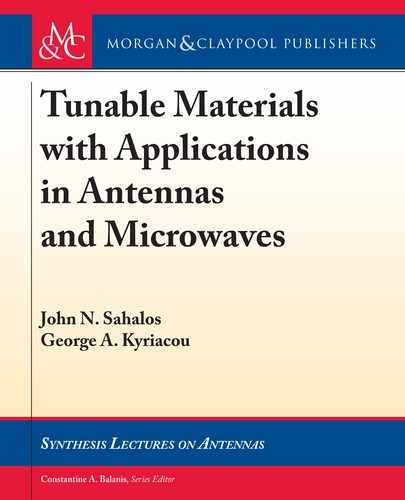
106 3. FINITE FERRITE SAMPLES
Let us now consider a uniform plane wave propagating in an arbitrary direction within a
uniformly Oz-biased infinite ferrite medium. e general solutions of (3.77) will take the follow-
ing form:
D
0
e
j
N
kNr
(3.78)
N
k D k
x
Ox C k
y
Oy C k
z
Oz and @=@x D j k
x
, @=@y D j k
y
and @=@z D j k
z
. In turn, Eq. (3.77)
reduces to:
.1 C X /
k
2
x
C k
2
y
C k
2
z
D 0: (3.79)
Let vector
N
k point to a direction forming an angle with respect to the biasing Oz-direction.
en, k
2
x
C k
2
y
D k
2
sin
2
and k
2
z
D k
2
cos
2
. Equation (3.79) becomes
.1 C X /k
2
sin
2
C k
2
cos
2
D 0 $ X sin
2
C 1 D 0: (3.80)
One may substitute X from (3.71) and solve either for the angle in terms of frequency
! or vice versa. In the latter case, we have
!
i
!
m
sin
2
D !
2
i
C !
2
(3.81a)
or ! D
q
!
i
!
i
C !
m
sin
2
: (3.81b)
Equation (3.81b) can be read as “a magnetostatic mode occurring at a specific frequency
! and propagating at a specific angle- and vice versa.” is is a well-known phenomenon
in waveguides, where each mode can be considered as a plane wave propagating in a zigzag
manner after successive reflections at the guide walls, but always at a specific constant angle
with respect to the propagation axis. Equation (3.81b) could then be interpreted as representing
a “self-guiding” property of magnetostatic modes in a uniformly magnetized ferrite.
Note, also the resemblance of (3.81b) to the spin-wave resonance equation. In fact, the
spin-wave resonance equation reduces to (3.81b) when either exchange interaction is ignored
(as herein), or when the wavenumber tends to zero k ! 0. More importantly, the magnetostatic
mode frequency (!) appears independent of wavenumber k. is means that multiple degenerate
modes exist at the same frequency and all wavelengths have the same energy. is degeneracy is
removed when exchange interaction is taken into account or when the boundaries of a practical
finite specimen are considered.
3.20 MAGNETOSTATIC MANIFOLD
A common straightforward approach employed for the derivation of an analytical solution of
the magnetostatic equation relies on the use of the separation of variables. is also yields the
conditions under which magnetostatic modes exist or defines their manifold. For this purpose,

3.20. MAGNETOSTATIC MANIFOLD 107
let the magnetic potential inside
i
and outside
.
e
/
the specimen be separated as follows:
i
D
i
.x; y; z/ D f
i
.x/g
i
.y/h
i
.z/ (3.82a)
e
D
e
.x; y; z/ D f
e
.x/g
e
.y/h
e
.z/: (3.82b)
e primed symbols denote derivatives (e.g., f
00
.x/ D d
2
f =dx
2
). We substitute (3.82)
into (3.76) and get
.1 C X /
f
00
i
f
i
C
g
00
i
g
i
C
h
00
i
h
i
D 0 (3.83a)
f
00
e
f
e
C
g
00
e
g
e
C
h
00
e
h
e
D 0: (3.83b)
As is often the case when exponential, sinusoidal or hyperbolic solutions are sought, we
may denote
f
00
=f D k
2
x
; g
00
=g D k
2
y
; h
00
=h D k
2
z
: (3.84)
Substituting expression (3.84) to (3.83a) and (3.83b), we have
.1 C X /
k
2
xi
C k
2
yi
C k
2
zi
D 0 (3.85a)
k
2
xe
C k
2
ye
C k
2
ze
D 0: (3.85b)
Without loss of generality, consider a partial solution of f
00
=f D k
2
x
in its exponential
form e
jk
x
x
, which corresponds to a positive k
2
x
and represents a uniform wave propagating
in the positive x-direction. In contrast, when k
2
x
is negative, this solution takes the form of
e
˛
x
x
, where k
2
x
D .j˛
x
/
2
D ˛
2
x
< 0 and ˛
x
> 0, which then represents a wave exponentially
decaying in the positive x-direction.
In view of the above, let us consider the possible solutions of (3.76) through (3.85).
From (3.85b) it is obvious that is impossible to enforce k
2
xe
; k
2
ye
; k
2
ze
to be either all positive
or all negative. At least one of them should be negative and the other two positive, or vice versa.
is means that in the air region surrounding the ferrite specimen, there will be an exponential
decay in at least one direction and propagation along the two other directions, or vice versa.
In the most common cases, the exponential attenuation occurs in the direction normal to the
ferrite specimen surface while the wave propagates along its surface. ese modes are classified
as surface waves when ordinary materials are considered. However, this does not apply to mag-
netostatic modes since all possible modes retain this property. In contrast, in the interior of the
ferrite specimen, there is an additional degree of freedom. is comes from the term .1 CX /,
which depends on the value of susceptibility X . To be more exact, the degree of freedom de-
pends on the sign of .1 C X / that controls the type of wave. us, when .1 C X / > 0, the same
..................Content has been hidden....................
You can't read the all page of ebook, please click here login for view all page.
